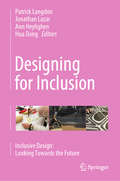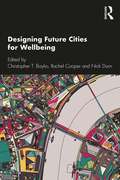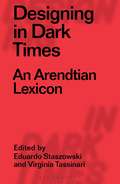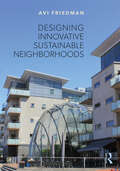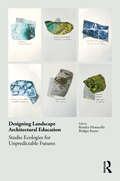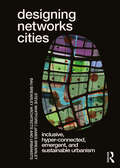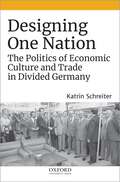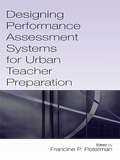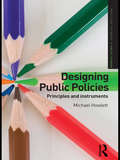- Table View
- List View
Designing for Inclusion: Inclusive Design: Looking Towards the Future
by Jonathan Lazar Patrick Langdon Ann Heylighen Hua DongThis proceedings book presents papers from the 10th Cambridge Workshops on Universal Access and Assistive Technology. The CWUAAT series of workshops have celebrated a long history of interdisciplinarity, including design disciplines, computer scientists, engineers, architects, ergonomists, ethnographers, ethicists, policymakers, practitioners, and user communities. This reflects the wider increasing realisation over the long duration of the series that design for inclusion is not limited to technology, engineering disciplines, and computer science but instead requires an interdisciplinary approach. The key to this is providing a platform upon which the different disciplines can engage and see each other’s antecedents, methods, and point of view.This proceedings book of the 10th CWUAAT conference presents papers in a variety of topics includingReconciling usability, accessibility, and inclusive design;Designing inclusive assistive and rehabilitation systems;Designing cognitive interaction with emerging technologies;Designing inclusive architecture;Data mining and visualising inclusion;Legislation, standards, and policy in inclusive design;Situational inclusive interfaces; andThe historical perspective: 20 years of CWUAAT.CWUAAT has always aimed to be inclusive in the fields that it invites to the workshop. We must include social science, psychologies, anthropologies, economists, politics, governance, and business. This requirement is now energised by imminent new challenges arising from techno-social change. In particular, artificial intelligence, wireless technologies, and the Internet of Things generate a pressing need for more socially integrated projects with operational consequences on individuals in the built environment and at all levels of design and society. Business cases and urgent environmental issues such as sustainability and transportation should now be a focus point for inclusion in an increasingly challenging world. This proceedings book continues the goal of designing for inclusion, as set out by the CWUAAT when it first started.
Designing Future Cities for Wellbeing
by Christopher T. BoykoDesigning Future Cities for Wellbeing draws on original research that brings together dimensions of cities we know have a bearing on our health and wellbeing – including transportation, housing, energy, and foodways – and illustrates the role of design in delivering cities in the future that can enhance our health and wellbeing. It aims to demonstrate that cities are a complex interplay of these various dimensions that both shape and are shaped by existing and emerging city structures, governance, design, and planning. Explaining how to consider these interconnecting dimensions in the way in which professionals and citizens think about and design the city for future generations’ health and wellbeing, therefore, is key. The chapters draw on UK case and research examples and make comparison to international cities and examples. This book will be of great interest to researchers and students in planning, public policy, public health, and design.
Designing Future Cities for Wellbeing
by Christopher T. Boyko Rachel Cooper Nick DunnDesigning Future Cities for Wellbeing draws on original research that brings together dimensions of cities we know have a bearing on our health and wellbeing – including transportation, housing, energy, and foodways – and illustrates the role of design in delivering cities in the future that can enhance our health and wellbeing. It aims to demonstrate that cities are a complex interplay of these various dimensions that both shape and are shaped by existing and emerging city structures, governance, design, and planning. Explaining how to consider these interconnecting dimensions in the way in which professionals and citizens think about and design the city for future generations’ health and wellbeing, therefore, is key. The chapters draw on UK case and research examples and make comparison to international cities and examples. This book will be of great interest to researchers and students in planning, public policy, public health, and design.
Designing High-Density Cities: For Social and Environmental Sustainability
by Edward NgCompact living is sustainable living. High-density cities can support closer amenities, encourage reduced trip lengths and the use of public transport and therefore reduce transport energy costs and carbon emissions. High-density planning also helps to control the spread of urban suburbs into open lands, improves efficiency in urban infrastructure and services, and results in environmental improvements that support higher quality of life in cities. Encouraging, even requiring, higher density urban development is a major policy and a central principle of growth management programmes used by planners around the world. However, such density creates design challenges and problems. A collection of experts in each of the related architectural and planning areas examines these environmental and social issues, and argues that high-density cities are a sustainable solution. It will be essential reading for anyone with an interest in sustainable urban development.
Designing High-Density Cities: For Social and Environmental Sustainability
by Edward NgCompact living is sustainable living. High-density cities can support closer amenities, encourage reduced trip lengths and the use of public transport and therefore reduce transport energy costs and carbon emissions. High-density planning also helps to control the spread of urban suburbs into open lands, improves efficiency in urban infrastructure and services, and results in environmental improvements that support higher quality of life in cities. Encouraging, even requiring, higher density urban development is a major policy and a central principle of growth management programmes used by planners around the world. However, such density creates design challenges and problems. A collection of experts in each of the related architectural and planning areas examines these environmental and social issues, and argues that high-density cities are a sustainable solution. It will be essential reading for anyone with an interest in sustainable urban development.
Designing in Dark Times: An Arendtian Lexicon (Designing in Dark Times)
by Eduardo Staszowski and Virginia TassinariThe architectural historian and critic Kenneth Frampton 'never recovered' from the force of Hannah Arendt's teaching at The New School in New York. The philosopher Richard J. Bernstein considers her the most perceptive political theorist and observer of 'dark times' (a concept which, drawing from Brecht, she made her own). Building on the revival of interest in Hannah Arendt, and on the increasing turn in design towards the expanded field of the social, this unique book uses insights and quotations drawn from Arendt's major writings (The Human Condition; The Origins of Totalitarianism, Men in Dark Times) to assemble a new kind of lexicon for politics, designing and acting today. Taking 56 terms – from Action, Beginnings and Creativity through Mortality, Natality, and Play to Superfluity, Technology and Violence – and inviting designers and scholars of design world-wide to contribute, Designing in Dark Times: An Arendtian Lexicon, offers up an extraordinary range of short essays that use moments and quotations from Arendt's thought as the starting points for reflection on how these terms can be conceived for contemporary design and political praxis. Neither simply dictionary nor glossary, the lexicon brings together designing and political philosophy to begin to create a new language for acting and designing against dark times.
Designing in Dark Times: An Arendtian Lexicon (Designing in Dark Times)
The architectural historian and critic Kenneth Frampton 'never recovered' from the force of Hannah Arendt's teaching at The New School in New York. The philosopher Richard J. Bernstein considers her the most perceptive political theorist and observer of 'dark times' (a concept which, drawing from Brecht, she made her own). Building on the revival of interest in Hannah Arendt, and on the increasing turn in design towards the expanded field of the social, this unique book uses insights and quotations drawn from Arendt's major writings (The Human Condition; The Origins of Totalitarianism, Men in Dark Times) to assemble a new kind of lexicon for politics, designing and acting today. Taking 56 terms – from Action, Beginnings and Creativity through Mortality, Natality, and Play to Superfluity, Technology and Violence – and inviting designers and scholars of design world-wide to contribute, Designing in Dark Times: An Arendtian Lexicon, offers up an extraordinary range of short essays that use moments and quotations from Arendt's thought as the starting points for reflection on how these terms can be conceived for contemporary design and political praxis. Neither simply dictionary nor glossary, the lexicon brings together designing and political philosophy to begin to create a new language for acting and designing against dark times.
Designing Industrial Policy in Latin America: Business-state Relations And The New Developmentalism (Latin American Political Economy)
by B. SchneiderDevelopment economists and practitioners agree that close collaboration between business and government improves industrial policy, yet little research exists on how best to organize that. This book examines three necessary functions–-information exchange, authoritative allocation, and reducing rent seeking–-across experiences in Latin America.
Designing Innovative Sustainable Neighborhoods
by Avi FriedmanThis book covers fundamental aspects of neighborhood planning and architecture along sustainable principles. Written by a designer and instructor, the book’s fully illustrated chapters provide detailed insights into contemporary strategies that architects, planners and builders are integrating into their thought processes and residential design practices. Past approaches to planning and design modes of dwellings and neighborhoods can no longer sustain new demands and require innovative thinking. This book explores new outlooks on neighborhood design, which are propelled by fundamental changes that touch upon environmental, economic and social aspects. It presents contemporary well-designed and illustrated examples of communities and detailed analysis of topics including the depletion of non-renewable natural resources, elevated levels of greenhouse gas emissions and climate change. It also explores the increasing costs of material, labor, land and infrastructure, which pose economic challenges; as well as social challenges including the need for walkable communities and the increase in live-work environments. The need to think innovatively about neighborhoods is at the core of this book, which will be useful to students and practitioners of urban design, urban planning, geography and urban systems; and to architecture studios focused on sustainable residential development.
Designing Innovative Sustainable Neighborhoods
by Avi FriedmanThis book covers fundamental aspects of neighborhood planning and architecture along sustainable principles. Written by a designer and instructor, the book’s fully illustrated chapters provide detailed insights into contemporary strategies that architects, planners and builders are integrating into their thought processes and residential design practices. Past approaches to planning and design modes of dwellings and neighborhoods can no longer sustain new demands and require innovative thinking. This book explores new outlooks on neighborhood design, which are propelled by fundamental changes that touch upon environmental, economic and social aspects. It presents contemporary well-designed and illustrated examples of communities and detailed analysis of topics including the depletion of non-renewable natural resources, elevated levels of greenhouse gas emissions and climate change. It also explores the increasing costs of material, labor, land and infrastructure, which pose economic challenges; as well as social challenges including the need for walkable communities and the increase in live-work environments. The need to think innovatively about neighborhoods is at the core of this book, which will be useful to students and practitioners of urban design, urban planning, geography and urban systems; and to architecture studios focused on sustainable residential development.
Designing Landscape Architectural Education: Studio Ecologies for Unpredictable Futures
by Rosalea Monacella Bridget KeaneNo single project or endeavour is immune to the issues that the climate crisis brings. The climate crisis encompasses a broad register of "symptoms" – increased global temperatures and sea-level rise, droughts and extreme bushfire events, salinification and desertification of fertile land, and the list goes on. It reveals and amplifies complex causal relationships that are inherently present and traverse scales, sectors and communities divulging a range of impacts and inequalities. This publication asks designers and academic practitioners to describe their own work through an ecological lens, and then to articulate design approaches for developing new practices in landscape architecture teaching. Designing Landscape Architectural Education: Studio Ecologies for Unpredictable Futures, the Landscape Architecture Design Studio Companion, serves as a resource for academic practitioners in the preparation and delivery of "design-research studios" and students seeking guidance for design methodologies as a part of their landscape architectural education. It draws on the manifold issues of the climate crisis as a set of drivers to examine the utilisation of a range of innovative design approaches to address the current and future priorities of the discipline. The landscape architecture discipline is evolving rapidly to respond to both a broadening and intensification of changes in the environmental, social and political conditions. These changing conditions require innovation that extend the core competencies of landscape architects. This book addresses two fundamental questions – what are the design competencies required of landscape architects to equip them to deal with the complexities brought forth by contemporary society, and as a result, how could we design the future design studio?
Designing Landscape Architectural Education: Studio Ecologies for Unpredictable Futures
by Rosalea Monacella and Bridget KeaneNo single project or endeavour is immune to the issues that the climate crisis brings. The climate crisis encompasses a broad register of "symptoms" – increased global temperatures and sea-level rise, droughts and extreme bushfire events, salinification and desertification of fertile land, and the list goes on. It reveals and amplifies complex causal relationships that are inherently present and traverse scales, sectors and communities divulging a range of impacts and inequalities. This publication asks designers and academic practitioners to describe their own work through an ecological lens, and then to articulate design approaches for developing new practices in landscape architecture teaching. Designing Landscape Architectural Education: Studio Ecologies for Unpredictable Futures, the Landscape Architecture Design Studio Companion, serves as a resource for academic practitioners in the preparation and delivery of "design-research studios" and students seeking guidance for design methodologies as a part of their landscape architectural education. It draws on the manifold issues of the climate crisis as a set of drivers to examine the utilisation of a range of innovative design approaches to address the current and future priorities of the discipline. The landscape architecture discipline is evolving rapidly to respond to both a broadening and intensification of changes in the environmental, social and political conditions. These changing conditions require innovation that extend the core competencies of landscape architects. This book addresses two fundamental questions – what are the design competencies required of landscape architects to equip them to deal with the complexities brought forth by contemporary society, and as a result, how could we design the future design studio?
Designing Local e-Government: The Pillars of Organizational Structure (Emerald Points)
by Israel Patiño GalvanIn the age of digitalization, even the way we govern is adapting. Recently, with the successful implementation of e-governments, the way our systems are organized has changed. Here, Israel Patiño Galvan suggests a specialized design structure as an alternative to the new, digital governments that are becoming increasingly more common. Through a thorough exploration of the history of these structures, and through field research in Mexico, serious deficiencies have been identified in the ways in which these e-governments have been implemented. Instead, Galvan offers a tri-phase solution to designing local governments, placing the direction and division of Information Technologies at the core to support the modernization and optimization process. For researchers and practitioners in public administration, information technologies, or information systems, this is a vital text providing a detailed case study as support for a new organizational system.
Designing Local e-Government: The Pillars of Organizational Structure (Emerald Points)
by Israel Patiño GalvanIn the age of digitalization, even the way we govern is adapting. Recently, with the successful implementation of e-governments, the way our systems are organized has changed. Here, Israel Patiño Galvan suggests a specialized design structure as an alternative to the new, digital governments that are becoming increasingly more common. Through a thorough exploration of the history of these structures, and through field research in Mexico, serious deficiencies have been identified in the ways in which these e-governments have been implemented. Instead, Galvan offers a tri-phase solution to designing local governments, placing the direction and division of Information Technologies at the core to support the modernization and optimization process. For researchers and practitioners in public administration, information technologies, or information systems, this is a vital text providing a detailed case study as support for a new organizational system.
Designing Modern Norway: A History of Design Discourse
by Kjetil FallanDesigning Modern Norway: A History of Design Discourse is an intellectual history of design and its role in configuring the modern Norwegian nation state. Rather than a conventional national design history survey that focuses on designers and objects, this is an in-depth study of the ideologies, organizations, strategies and politics that combined might be said to have "designed" the modern nation's material and visual culture. The book analyses main tropes and threads in the design discourse generated around key institutions such as museums, organisations and magazines. Beginning with how British and continental design reform ideas were mediated in Norway and merged with a nationalist sentiment in the late nineteenth century, Designing Modern Norway traces the tireless and wide-ranging work undertaken by enthusiastic and highly committed design professionals throughout the twentieth century to simultaneously modernise the nation by design and to nationalise modern design. Bringing the discussion up towards the present, the book concludes with an examination of how Norway's new-found wealth has profoundly changed the production, mediation and consumption of design.
Designing Modern Norway: A History of Design Discourse
by Kjetil FallanDesigning Modern Norway: A History of Design Discourse is an intellectual history of design and its role in configuring the modern Norwegian nation state. Rather than a conventional national design history survey that focuses on designers and objects, this is an in-depth study of the ideologies, organizations, strategies and politics that combined might be said to have "designed" the modern nation's material and visual culture. The book analyses main tropes and threads in the design discourse generated around key institutions such as museums, organisations and magazines. Beginning with how British and continental design reform ideas were mediated in Norway and merged with a nationalist sentiment in the late nineteenth century, Designing Modern Norway traces the tireless and wide-ranging work undertaken by enthusiastic and highly committed design professionals throughout the twentieth century to simultaneously modernise the nation by design and to nationalise modern design. Bringing the discussion up towards the present, the book concludes with an examination of how Norway's new-found wealth has profoundly changed the production, mediation and consumption of design.
Designing More-than-Human Smart Cities: Beyond Sustainability, Towards Cohabitation
Climate change, rapid urbanisation, pandemics, as well as innovations in technologies such as blockchain, AI and IoT are all impacting urban space. One response to such changes has been to make cities ecologically sustainable and 'smart'. The 'eco smart city' for instance uses networked sensing, cloud and mobile computing to optimise, control, and regulate urban processes and resources. From real-time bus information to autonomous electric vehicles, smart parking, and smart street lighting, such initiatives are often presented as a social and environmental good. Critics, however, increasingly argue that technologically driven, and efficiency-led approaches are too simplistic to deal with the complexities of urban life. Sustainability in the smart city is predominantly performed in limited ways that leave little room for participation and citizen agency despite government efforts to integrate innovative technologies in more equitable ways. More importantly, there is a growing awareness that a human-centred notion of cities, in which urban space is designed for, and inhabited by, humans only, is no longer tenable. Within the age of the Anthropocene - a term used to refer to a new geological era in which human activity is transforming Earth systems, accelerating climate change and causing mass extinctions - scholars and practitioners are working generatively by acknowledging the entanglements between human and non-human others (including plants, animals, insects, as well as soil, water, and sensors and their data) in urban life. In Designing More-than-Human Smart Cities, renowned researchers and practitioners from urban planning, architecture, environmental humanities, geography, design, arts, and computing critically explore smart cities beyond a human-centred approach. They respond to the complex interrelations between human and non-human others in urban space. Through theory, policy and practice (past and present), and thinking speculatively about how smart cities may evolve in the future, the book makes a timely contribution to lively, contemporary scientific and political debates on genuinely sustainable smart cities.
Designing Networks Cities: Inclusive, Hyper-Connected, Emergent, and Sustainable Urbanism
by Steve Whitford James Brearleydesigning networks cities presents a sophisticated, multi-disciplinary, and multi-dimensional approach to urban design. Emerging from years of practice, experimentation, and research by designers (landscape architects, urban planners, urban designers and architects), this approach engages with contemporary thought across a number of disciplines to re-invent the entrenched blunt instruments of the city making process. A cry for flexible, sharp-instruments in urban design, designing networks cities presents a multi-dimensional way of seeing the essential components of the city (form, space-time, order and aesthetics). It purposefully links traditional architectural design derivation mechanisms to urban design, in the hope that cities will not only be pragmatic, but also become sophisticated iconographically, poetically, and syntactically. It provides the tools to enable decision making within a multiplicity of constraints and opportunities: a philosophy of becoming, not being; a science of dynamic systems, not stasis; and an art of sensations, not subjectivity. And finally, and most importantly, it argues why it is important that cities embrace these multiple dimensions of society on a planet that is facing increasing environmental challenges: an economics focused on equity for all, not for some more than others; a politics supporting a genuine representational democracy, not one representing the overly influential; and a culture [including history] that embraces difference, not one that encourages division. designing networks cities not only provides the means to identify these issues and a methodology to deal with them within a complex emerging co-existence, but also demonstrates the development of cities that embrace and respond to the complexities of life in what some are calling the Anthropocene.
Designing Networks Cities: Inclusive, Hyper-Connected, Emergent, and Sustainable Urbanism
by Steve Whitford James Brearleydesigning networks cities presents a sophisticated, multi-disciplinary, and multi-dimensional approach to urban design. Emerging from years of practice, experimentation, and research by designers (landscape architects, urban planners, urban designers and architects), this approach engages with contemporary thought across a number of disciplines to re-invent the entrenched blunt instruments of the city making process. A cry for flexible, sharp-instruments in urban design, designing networks cities presents a multi-dimensional way of seeing the essential components of the city (form, space-time, order and aesthetics). It purposefully links traditional architectural design derivation mechanisms to urban design, in the hope that cities will not only be pragmatic, but also become sophisticated iconographically, poetically, and syntactically. It provides the tools to enable decision making within a multiplicity of constraints and opportunities: a philosophy of becoming, not being; a science of dynamic systems, not stasis; and an art of sensations, not subjectivity. And finally, and most importantly, it argues why it is important that cities embrace these multiple dimensions of society on a planet that is facing increasing environmental challenges: an economics focused on equity for all, not for some more than others; a politics supporting a genuine representational democracy, not one representing the overly influential; and a culture [including history] that embraces difference, not one that encourages division. designing networks cities not only provides the means to identify these issues and a methodology to deal with them within a complex emerging co-existence, but also demonstrates the development of cities that embrace and respond to the complexities of life in what some are calling the Anthropocene.
Designing One Nation: The Politics of Economic Culture and Trade in Divided Germany
by Katrin SchreiterThis is an open access title available under the terms of a CC BY-NC-ND 4.0 International License. It is free to read at Oxford Scholarship Online and offered as a free PDF download from OUP and selected open access locations, thanks to a generous grant from the Andrew W. Mellon Foundation. The histories of East and West Germany traditionally emphasize the Cold War rivalries between the communist and capitalist nations. Yet, even as the countries diverged in their political directions, they had to create new ways of working together economically. In Designing One Nation, Katrin Schreiter examines the material culture of increasing economic contacts in divided Germany from the 1940s until the 1990s. Trade events, such as fairs and product shows, became one of the few venues for sustained links and knowledge between the two countries after the building of the Berlin Wall. Schreiter uses industrial design, epitomized by the furniture industry, to show how a network of politicians, entrepreneurs, and cultural brokers attempted to nationally re-inscribe their production cultures, define a postwar German identity, and regain economic stability and political influence in postwar Europe. What started as a competition for ideological superiority between East and West Germany quickly turned into a shared, politically legitimizing quest for an untainted post-fascist modernity. This work follows products from the drawing board into the homes of ordinary Germans to offer insights into how converging visions of German industrial modernity created shared expectations about economic progress and living standards. Schreiter reveals how intra-German and European trade policies drove the creation of products and generated a certain convergence of East and West German taste by the 1980s. Drawing on a wide range of sources from governments, furniture firms, industrial design councils, home lifestyle magazines, and design exhibitions, Designing One Nation argues that an economic culture linked the two Germanies even before reunification in 1990.
Designing One Nation: The Politics of Economic Culture and Trade in Divided Germany
by Katrin SchreiterThis is an open access title available under the terms of a CC BY-NC-ND 4.0 International License. It is free to read at Oxford Scholarship Online and offered as a free PDF download from OUP and selected open access locations, thanks to a generous grant from the Andrew W. Mellon Foundation. The histories of East and West Germany traditionally emphasize the Cold War rivalries between the communist and capitalist nations. Yet, even as the countries diverged in their political directions, they had to create new ways of working together economically. In Designing One Nation, Katrin Schreiter examines the material culture of increasing economic contacts in divided Germany from the 1940s until the 1990s. Trade events, such as fairs and product shows, became one of the few venues for sustained links and knowledge between the two countries after the building of the Berlin Wall. Schreiter uses industrial design, epitomized by the furniture industry, to show how a network of politicians, entrepreneurs, and cultural brokers attempted to nationally re-inscribe their production cultures, define a postwar German identity, and regain economic stability and political influence in postwar Europe. What started as a competition for ideological superiority between East and West Germany quickly turned into a shared, politically legitimizing quest for an untainted post-fascist modernity. This work follows products from the drawing board into the homes of ordinary Germans to offer insights into how converging visions of German industrial modernity created shared expectations about economic progress and living standards. Schreiter reveals how intra-German and European trade policies drove the creation of products and generated a certain convergence of East and West German taste by the 1980s. Drawing on a wide range of sources from governments, furniture firms, industrial design councils, home lifestyle magazines, and design exhibitions, Designing One Nation argues that an economic culture linked the two Germanies even before reunification in 1990.
Designing Performance Assessment Systems for Urban Teacher Preparation
by Francine P. PetermanDesigning Performance Assessment Systems for Urban Teacher Preparation presents an argument for, and invites, critical examination of teacher preparation and assessment practices--in light of both the complexity and demands of urban settings and the theories of learning and learning to teach that guide teacher education practices. This dynamic approach distinguishes the authors' stance on urban teacher assessment as one that can help address social justice issues related to gender, race, socioeconomic class, and other differences, and at the same time promote the professional development of all educators engaged in the process of learning to teach. The contextually bound, sociocultural stance that informs this book promises greater teacher and student achievement.Culminating six years of vital dialogue and focused, local activity among teachers and teacher educators from institutions in the Urban Network to Improve Teacher Education, Designing Performance Assessment Systems for Urban Teacher Preparation presents:*the historical context that was examined for this work, a theoretical framework to undergrad teacher preparation assessment, and design principles to guide the development of assessment systems;*four case studies of participants' struggles and successes in designing and implementing these systems; and*a discussion of the importance of context and current trends in assessment practices in urban teaching.This volume is particularly relevant for university and school-based teacher educators who help prepare teachers to work in urban schools, and for personnel in state departments of education and other agencies who are responsible for certification and beginning teacher support. While the focus is on preparing teachers for urban settings, the theoretical and practical foundations and the case studies have broad implications and provide useful insights for anyone involved in developing and using performance assessment systems--teacher educators, university and school administrators, classroom teachers, and educational researchers.
Designing Performance Assessment Systems for Urban Teacher Preparation
by Francine P. PetermanDesigning Performance Assessment Systems for Urban Teacher Preparation presents an argument for, and invites, critical examination of teacher preparation and assessment practices--in light of both the complexity and demands of urban settings and the theories of learning and learning to teach that guide teacher education practices. This dynamic approach distinguishes the authors' stance on urban teacher assessment as one that can help address social justice issues related to gender, race, socioeconomic class, and other differences, and at the same time promote the professional development of all educators engaged in the process of learning to teach. The contextually bound, sociocultural stance that informs this book promises greater teacher and student achievement.Culminating six years of vital dialogue and focused, local activity among teachers and teacher educators from institutions in the Urban Network to Improve Teacher Education, Designing Performance Assessment Systems for Urban Teacher Preparation presents:*the historical context that was examined for this work, a theoretical framework to undergrad teacher preparation assessment, and design principles to guide the development of assessment systems;*four case studies of participants' struggles and successes in designing and implementing these systems; and*a discussion of the importance of context and current trends in assessment practices in urban teaching.This volume is particularly relevant for university and school-based teacher educators who help prepare teachers to work in urban schools, and for personnel in state departments of education and other agencies who are responsible for certification and beginning teacher support. While the focus is on preparing teachers for urban settings, the theoretical and practical foundations and the case studies have broad implications and provide useful insights for anyone involved in developing and using performance assessment systems--teacher educators, university and school administrators, classroom teachers, and educational researchers.
Designing Public Policies: An Approach Based on Multi-Criteria Analysis and Computable General Equilibrium Modeling (Lecture Notes in Economics and Mathematical Systems #642)
by Francisco J. André M. Alejandro Cardenete Carlos RomeroThis monograph provides a novel approach to the evaluation of economic policy by combining two different analytical strategies. On the one hand, the computable general equilibrium (CGE) analysis, a standard tool mostly used to quantify the impact of economic measures or changes in the structural data of the economy. On the other hand, the multiple criteria decision-making (MCDM) approach, an op- misation technique that deals with problems with more than one objective. Ty- cally, CGE is well suited for the analysis of the interactions of multiple agents from the point of view of a planner single objective. Combining this technique with the MCDM approach allows developing models in which we ?nd many interacting agents and a decision maker with several objectives. The contribution of this work is partly methodological and partly applied. It provides a framework for the analysis of this type of problems, as well as a series of applications in which the strength of the approach is made clear. The consideration of environmental problems, as a speci?c ?eld in which this technique of analysis can be used, is particularly well chosen. The environmental concern keeps growing steadily and has already become an issue in most of the standard economic decisions. It is therefore extremely important to ?nd systematic ways to introduce such a concern in the models with which we evaluate the impact of policy measures.
Designing Public Policies: Principles and Instruments
by Michael HowlettThis textbook provides a concise and accessible introduction to the principles and elements of policy design in contemporary governance. Howlett seeks to examine in detail the range of substantive and procedural policy instruments that together comprise the toolbox from which governments select specific tools expected to resolve policy problems. Guiding students through the study of the instruments used by governments in carrying out their tasks, adapting to, and altering, their environments, this book: Discusses several current trends in instrument use often linked to factors such as globalization and the increasingly networked nature of modern society. Considers the principles behind the selection and use of specific types of instruments in contemporary government. Evaluates in detail the merits, demerits and rationales for the use of specific organization, regulatory, financial and information-based tools and the trends visible in their use Addresses the issues of instrument mixes and their (re)design in a discussion of the future research agenda of policy design. Providing a comprehensive overview of this essential component of modern governance and featuring helpful definitions of key concepts and further reading, this book is essential reading for all students of public policy, administration and management.
